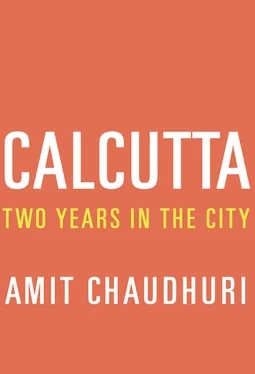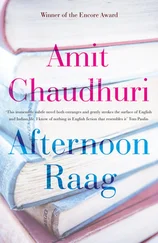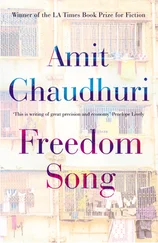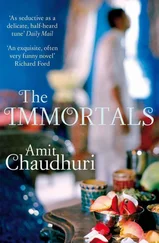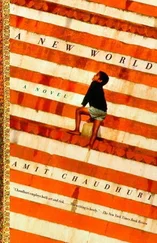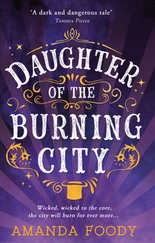The difficulty of evolving as an artist, of resigning yourself to the fact that the styles and visions most precious to you have lost their place and urgency, of accepting that what you once thought was uninteresting is now full of possibility! One can see the photographer Raghubir Singh working his way through this dilemma. Here was a man clearly formed by Henri Cartier-Bresson and Satyajit Ray, by the pursuit of the image in which the random and the everyday, in a lucky moment, come together. This quiet pursuit marks his famous photographs of Calcutta, in the book The Home and the Street . Yet, today, most of those pictures look strangely dated — it’s as if Singh can’t quite access Cartier-Bresson’s aesthetic, and Calcutta’s; all the details are there, but something impedes him; Cartier-Bresson and Calcutta, by 1988, are slipping into history, and Singh must have a troubling intimation of this fact.
Then, five years before he died, Singh published, in 1994, Bombay: Gateway to India . He came into his own in these photographs — of rich people’s villas and drawing rooms; celebrities; handcart pullers; balloon sellers; a glass shop front; the interiors of a jeweller’s. The world had changed; Raghubir Singh changed too. He turned from Cartier-Bresson’s and Satyajit Ray’s provisional and natural movements on the streets; instead, as V. S. Naipaul notices, glass recurs as a motif in these photographs — shop windows; glass doorways; mirrors; chandeliers. Where there was, once, organic colour, light, and shadow, there are now constant hints of refracted, ambivalent, polished surfaces. Singh doesn’t become a postmodernist — but he abandons the wonderstruck poetry of derelict modernity to become a formalist chronicler of a new terrain.
This is a little parable about cities and genres; how, while some of them lose their imaginative centrality, others take their place.
* * *
I’ve said that, as Calcutta fizzled out with globalisation, two other cities moved centre stage decisively. One, Bombay, became effectively what Calcutta once had been, the Indian metropolis, with the invigorating, defining extremities of experience that great cities possess. But Bombay was always singular. The other city, New Delhi, which had been waiting in the wings in the decades since Independence, was an unimportant, provincial small town. It was bureaucratic, boring, notwithstanding the fact that it was the capital of India. My memories from the late sixties and the early seventies are, however, charming: I had the sense of having visited the distilled, slightly fusty quiet of a town like Poona, or a cantonment area. There were trees and avenues and, since we only ever went in the winter, bare branches against the sky. At least a few people we knew had houses with fireplaces: that was one of the things I liked about Delhi — that, unlike Bombay and Calcutta, people could live there in houses. Many of these had probably come up in the sixties. They had a bare, spacious, habitable air that only just escaped governmental dullness into a post-Independence tranquillity. My New Delhi, in those few visits, was determined by a privileged topography: Connaught Place, Khan Market, the Jantar Mantar, the Ashoka and the Oberoi Intercontinental hotels, the India International Centre, which was then struggling to be born. None of these, however, felt like a hub, and that was what was pleasant about them: it was easy to believe, in Delhi, that life was happening somewhere else. Many of these areas had a weather that was postcolonial, post-Independence, and pre-globalisation: a genuine fragile socialist newness pertained to them, a little uninteresting, but unique, like a rare, carefully tended flower. There was no culture to speak of; instead, there were the state-sponsored museums we visited — an international dolls’ museum; a museum of Gandhi’s life — cautious places, and, like the textbooks at school, distrustful of personality; but, like the nation-state of the time, doggedly uplifting. The nation-state, and its great myth, “unity in diversity,” also strongly approached my mother and me from the various retail outlets she visited on Janpath: the national and regional handicrafts stores; and that many-tiered monument there, a paean to the rich layers of Indian identity, the Cottage Industries building.
I encountered the changed New Delhi in Oxford. It had receded in my consciousness. Delhi had been a place of indefatigable parliamentary activity — the politics of India is the politics of survival — of, in the eighties, political murders, Mrs. Gandhi’s assassination and its violent aftermath. But it was still difficult to experience it, with its India Gates and Avenues of Peace, as a city.
In Oxford, during my first year there, I sensed a change. It was difficult to put one’s finger on it; shifts in attitude, in ideas, in power, are felt, in the beginning, as an unease, like a small physical discomfort. Almost all the Indian students I met in my first two years in Oxford — the ones who’d come there on the two or three available scholarships of prestige — were from Delhi, in particular, from St. Stephen’s College. A minority of the Delhi students were from the Hindu College. The rest of the Indians were from other places. Everyone in India now knows of St. Stephen’s, but, in 1987, it had no special resonance. Its aura and ascendancy as the leading educational institution in India was still in the making, as Delhi, as a centre of power, was also being made. In Oxford, I was a witness to the making, and had my first intimation of power. I remember it taking me a bit by surprise, as if the changes had happened without my knowledge, until I began to become aware of them in the students’ rooms.
Most Delhi Indians had come to “read” either history or politics or economics, or to do graduate work in these disciplines. They may not have been from Delhi originally; but (it quickly became clear) almost all the conduits in India to higher education in Oxbridge were now in the capital. It didn’t matter if you hadn’t been born there; you needed to inhale its air, absorb the mood that made your aspirations and the aspirations of the nation-state flow into each other. There was no looking back for them. Many were planning for further fellowships — the next stop would be an American university — or to return to India, some to the Indian Administrative Services or one of the other elite and elderly wings of the Indian bureaucracy. And as there was no pause to this onward march, these students seldom felt any homesickness. In fact, homesickness was seen as something ridiculous — a reference to a homesick person was accompanied by giggles. What were you doing here, if you were homesick?
The fascination for the Indian Administrative Service was puzzling. I hadn’t come across it in Bombay, with its attraction to American business schools, or in Calcutta, with its worship of doctors and engineers. Not even Kipling, with his covert admiration of power, could view the Indian Civil Service — whose numbers once counted among the “heaven-born”—without irony. And what about the “idea of India,” which I’d encountered as a child in Delhi in those handicrafts shops and in the Cottage Industries building? Could one entertain it without a mixture of affection and deprecation? But the “idea of India” was no longer, in 1987, an indigenous, handwoven, state-subsidised thing: it was going to be, for the young self-appointed overcoat-and-scarf-wearing vanguard I met in Oxford, a proper vocation. They didn’t regard this idea with irony — instead, they viewed it with a sense of custodianship. It was going to be in their safekeeping.
* * *
I live in India much of the year — but I can’t say I like the India of today. That “Delhi of the mind,” which I first encountered in Oxford, which was then young and tentative, is, in 2011, entrenched and middle-aged. It sits on everything, unbudgeable: on university committees; the civil service; funding bodies; the print and electronic media. And you hear its voice through people who are talking all the time: not in drawing rooms, but on television. The television studio, and, really, the flashing screen itself, has taken over from the drawing room as the venue where the powerful and influential are invited to congregate and chatter.
Читать дальше
